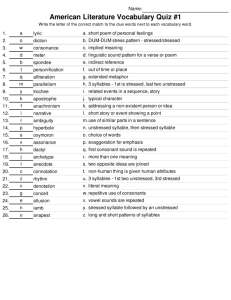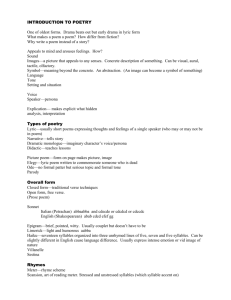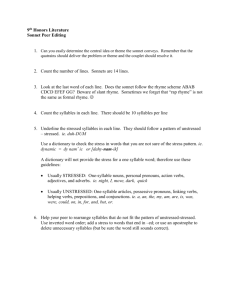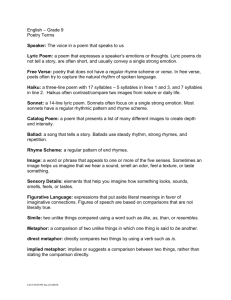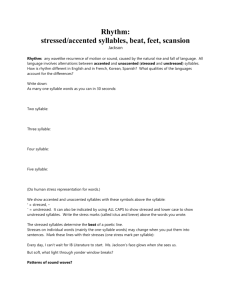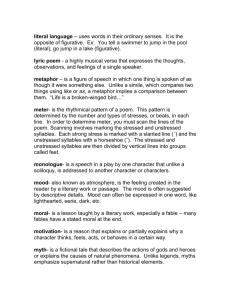SOL 10.5a, c Rhyme, Rhythm, Meter Rhyme is the repetition of
advertisement
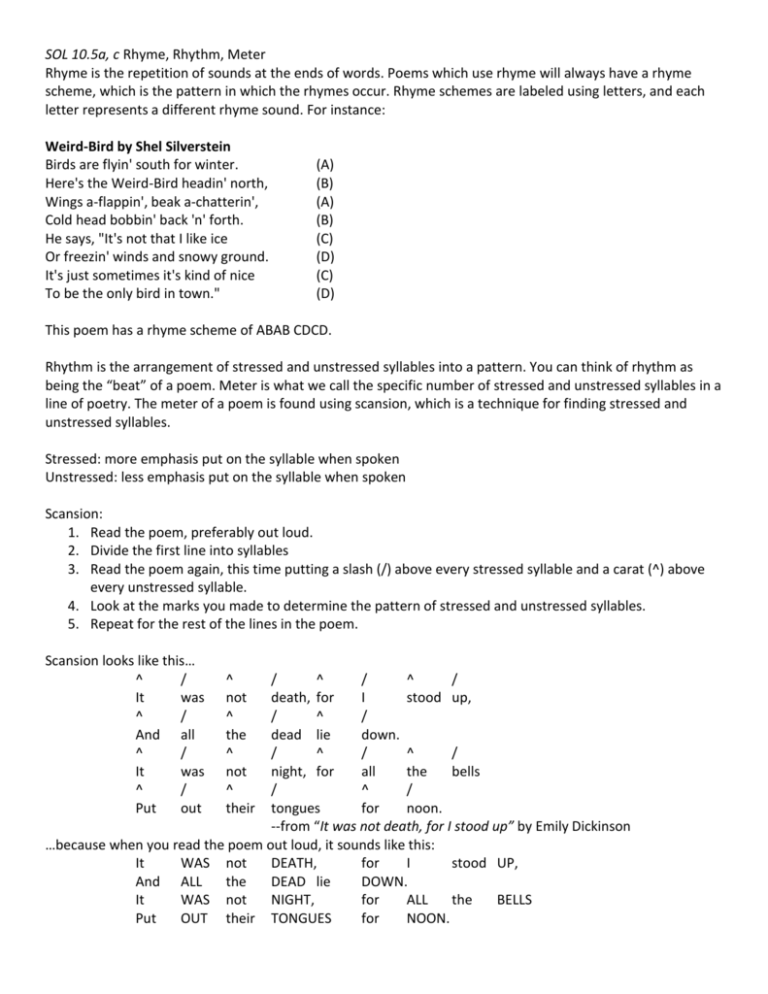
SOL 10.5a, c Rhyme, Rhythm, Meter Rhyme is the repetition of sounds at the ends of words. Poems which use rhyme will always have a rhyme scheme, which is the pattern in which the rhymes occur. Rhyme schemes are labeled using letters, and each letter represents a different rhyme sound. For instance: Weird-Bird by Shel Silverstein Birds are flyin' south for winter. Here's the Weird-Bird headin' north, Wings a-flappin', beak a-chatterin', Cold head bobbin' back 'n' forth. He says, "It's not that I like ice Or freezin' winds and snowy ground. It's just sometimes it's kind of nice To be the only bird in town." (A) (B) (A) (B) (C) (D) (C) (D) This poem has a rhyme scheme of ABAB CDCD. Rhythm is the arrangement of stressed and unstressed syllables into a pattern. You can think of rhythm as being the “beat” of a poem. Meter is what we call the specific number of stressed and unstressed syllables in a line of poetry. The meter of a poem is found using scansion, which is a technique for finding stressed and unstressed syllables. Stressed: more emphasis put on the syllable when spoken Unstressed: less emphasis put on the syllable when spoken Scansion: 1. Read the poem, preferably out loud. 2. Divide the first line into syllables 3. Read the poem again, this time putting a slash (/) above every stressed syllable and a carat (^) above every unstressed syllable. 4. Look at the marks you made to determine the pattern of stressed and unstressed syllables. 5. Repeat for the rest of the lines in the poem. Scansion looks like this… ^ / It was ^ / And all ^ / It was ^ / Put out ^ not ^ the ^ not ^ their / ^ / ^ / death, for I stood up, / ^ / dead lie down. / ^ / ^ / night, for all the bells / ^ / tongues for noon. --from “It was not death, for I stood up” by Emily Dickinson …because when you read the poem out loud, it sounds like this: It WAS not DEATH, for I stood UP, And ALL the DEAD lie DOWN. It WAS not NIGHT, for ALL the BELLS Put OUT their TONGUES for NOON. Try scanning the lines below: For the moon never beams without bringing me dreams Of the beautiful Annabel Lee; And the stars never rise but I feel the bright eyes Of the beautiful Annabel Lee --from “Annabel Lee” by Edgar Allan Poe Each group of stressed and unstressed syllables is called a foot. There are several different kinds of poetic feet, but the most common are the iamb, the trochee, the dactyl, and the anapest. iamb: unstressed syllable followed by a stressed syllable (^/) trochee: stressed syllable followed by an unstressed syllable (/^) dactyl: stressed syllable followed by two unstressed syllables (/^^) anapest: two unstressed syllables followed by a stressed syllable (^^/) Rhythm is one element of poetry that gives poems a musical quality; that is, makes them sound similar to songs. A limerick is a funny, often crude poem that has a specific rhyme scheme and meter. For example: ^ ^ / ^ ^ / ^ ^ / As a student in high school, I aced (A) ^ ^ / ^ ^ / ^ ^ / Each exam that I faced and was placed (A) ^ ^ / ^ ^ / At the top of the class, (B) ^ ^ / ^ ^ / Which was nice but alas, (B) ^ ^ / ^ ^ / ^ ^ / While my friends were all chased, I was chaste. (A) This limerick has a rhyme scheme of AABBA and the type of foot is the trochee. There are three feet in the first, second, and fifth lines and two feet in the third and fourth lines. All limericks follow this pattern. Though the student's intentions were good, His attention still strayed where it would. "Aw, teacher, I tried!" "But your mind's not applied. So: detention. Is that understood?"
